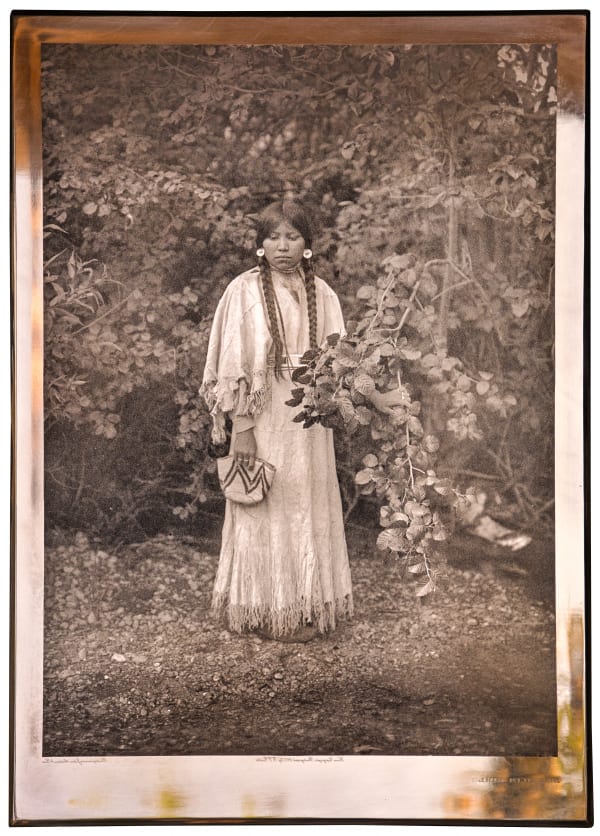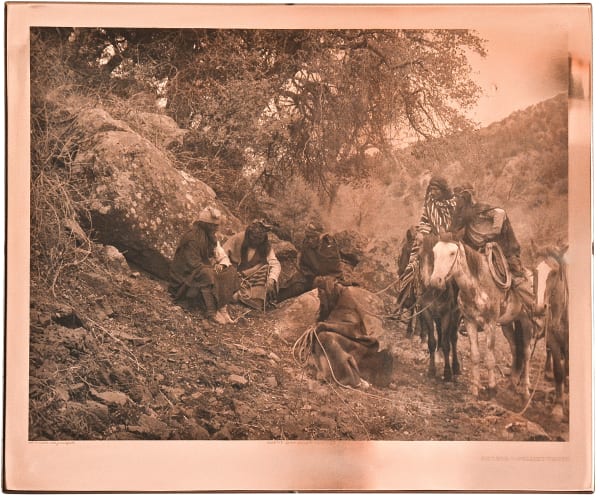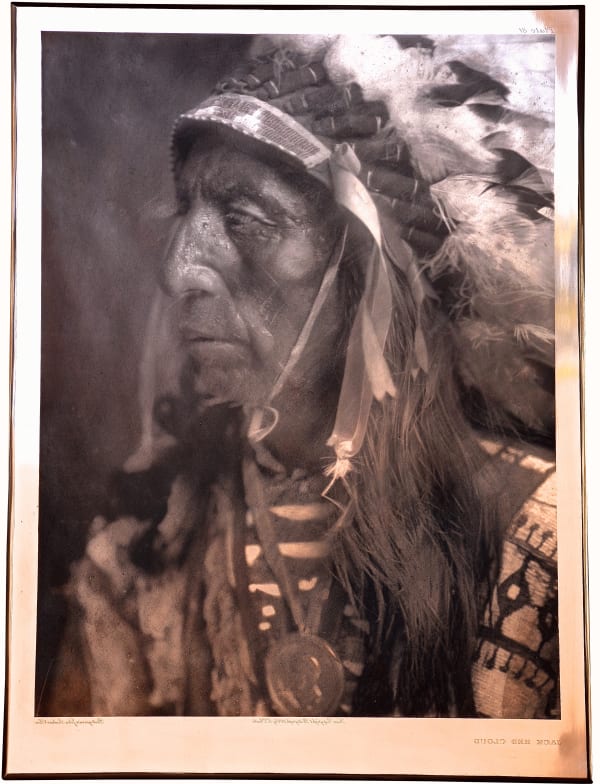Copper Photogravure Printing Plates
Edward Curtis began work on these Copper Photogravure Printing Plates in 1906 to produce the images in his The North American Indian: Being a Series of Volumes Picturing and Describing the Indians of United States and Alaska, and would work on them continuously until the project was finally completed in 1928.
Significantly, the Copper Photogravure Printing Plates are the source of origin for every vintage photogravure print extant produced in The North American Indian. All of the images in The North American Indian, in large and small formats, were printed from these exquisitely prepared Copper Photogravure Printing Plates, the very same as the ones seen here. Each plate is a unique work and a primary document of one of the most significant publishing ventures of the 20th century.
The quality of the Photogravure Printing Plates was of primary importance to Curtis throughout the publication of The North American Indian. In 2005, at the Braun Research Library, Autry National Center in Los Angeles, Curtis scholar Bruce Kapson unearthed a 44-year cache of correspondence between Curtis and Frederick Webb Hodge, editor of The North American Indian. Throughout this decades-long exchange, Curtis describes in detail the meticulous care he continually took with his photoengraver to perfect the imagery on the copper plates.
Edward S. Curtis would go on to spend more time perfecting the imagery of each Copper Photogravure Printing Plate than on anything else he ever printed or any of his other photographic processes. He would repeatedly go up and back with his photoengraver working a plate until he was able to produce what he considered perfect. Each finished Copper Photogravure Printing Plate represents Curtis' most evolved vision for the images used in The North American Indian.
The Copper Photogravure Printing Plates possess a breathtaking beauty and elegance, making them compelling objects of art in and of themselves. The light reflecting off the engraved copper adds a three-dimensional quality to the image on the Plate. The three-dimensionality of these polished copper plates offers a wholly new material and singular aesthetic experience, one that is distinct from Curtis's gravures, photographic prints, and goldtones. These Plates are the most compellingly beautiful pieces found in this artist's staggeringly beautiful body of work.
The Copper Photogravure Printing Plates presented by the Bruce Kapson Gallery are all in excellent original condition and carefully conserved to their original untreated copper and inked state with no protective sealant or enhancement applied to alter the Copper Photogravure Printing Plate from its original state.
-
 Old Person – Piegan, 1911
Old Person – Piegan, 1911 -
 In The Land Of The Sioux, 1905
In The Land Of The Sioux, 1905 -
 Ready For The Charge – Apsaroke, 1908
Ready For The Charge – Apsaroke, 1908 -
 Nespilm Girl, 1905
Nespilm Girl, 1905 -
 Offering The Buffalo Skull - Mandan, 1908
Offering The Buffalo Skull - Mandan, 1908 -
 Crying To The Spirits, 1908
Crying To The Spirits, 1908 -
 White Man Runs Him, 1908
White Man Runs Him, 1908 -
 Lodge Interior - Piegan, 1908
Lodge Interior - Piegan, 1908 -
 Incense Over The Medicine Bundle - Hidatsa , 1908
Incense Over The Medicine Bundle - Hidatsa , 1908 -
 Nunalalahl - Qagyuhl, 1914
Nunalalahl - Qagyuhl, 1914 -
 Canon de Chelly - Navaho, 1904
Canon de Chelly - Navaho, 1904 -
 Chief Joseph – Nez Perce, 1903
Chief Joseph – Nez Perce, 1903 -
 Duck Hunter – Kutenai, 1910
Duck Hunter – Kutenai, 1910 -
 Shot In The Hand – Apsaroke, 1908
Shot In The Hand – Apsaroke, 1908 -
 Canon del Muerto - Navaho, 1906
Canon del Muerto - Navaho, 1906 -
 On The Little Bighorn – Apsaroke, 1908
On The Little Bighorn – Apsaroke, 1908 -
 Wolf – Apsaroke, 1908
Wolf – Apsaroke, 1908 -
 Lone Flag – Atsina, 1908
Lone Flag – Atsina, 1908 -
 A War Chief – Nez Perce, 1905
A War Chief – Nez Perce, 1905 -
 Piegan Dandy, 1900
Piegan Dandy, 1900 -
 The Chief And His Staff – Apsaroke, 1905
The Chief And His Staff – Apsaroke, 1905 -
 High Hawk, 1907
High Hawk, 1907 -
 Two Moons - Cheyenne, 1910
Two Moons - Cheyenne, 1910 -
 The Piegan, 1910
The Piegan, 1910 -
 The Eagle Catcher, 1908
The Eagle Catcher, 1908 -
 A Tewa Girl, 1921
A Tewa Girl, 1921 -
 A Snake Priest, 1900
A Snake Priest, 1900 -
 The Scout - Apache, 1906
The Scout - Apache, 1906 -
 The Storm - Apache, 1906
The Storm - Apache, 1906 -
 Geronimo - Apache, 1905
Geronimo - Apache, 1905 -
 Apache Guan, 1908
Apache Guan, 1908 -
 Pulini and Koyame - Walpi, 1921
Pulini and Koyame - Walpi, 1921 -
 A Son Of The Desert - Navaho, 1904
A Son Of The Desert - Navaho, 1904 -
 Lone Fox - Assiniboin , 1908
Lone Fox - Assiniboin , 1908 -
 Piegan Encampment, 1900
Piegan Encampment, 1900 -
 Story Telling - Apache, 1903
Story Telling - Apache, 1903 -
 Weasel Tail – Piegan, 1900
Weasel Tail – Piegan, 1900 -
 Jack Red Cloud, 1907
Jack Red Cloud, 1907 -
 White Man Runs Him – Apsaroke, 1908
White Man Runs Him – Apsaroke, 1908 -
 The Fisherman - Wishham, 1909
The Fisherman - Wishham, 1909 -
 For A Winter Campaign - Apsaroke, 1908
For A Winter Campaign - Apsaroke, 1908 -
 The Three Chiefs - Piegan, 1900
The Three Chiefs - Piegan, 1900










































